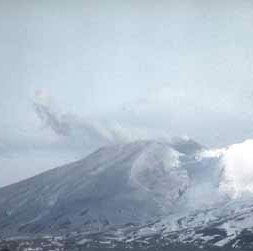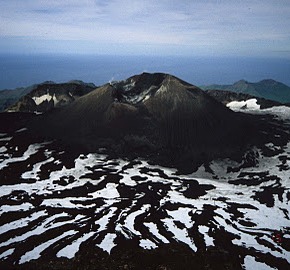|
Volcanoes are mountains which are
connected to the molten rock in the center of the earth.
There are three types of volcanoes: cinder cone, shield,
and composite cone. Each kind of volcano forms in a
slightly different way but each one can erupt with
amazing force. Because of their unpredictability,
forecasting volcanic eruptions is an inexact science for
those at the Alaska Volcano Observatory, an organization
made up of a team of researchers from the U.S.
Geological Survey, the UAF Geophysical Institute and the
Alaska Division of Geological and Geophysical Surveys,
with centers in Fairbanks and Anchorage.
Most all of Alaska's volcanoes are located along the
1,500 mile Aleutian Arc that extends westward to
Kamchatka and forms the northern part of the Pacific
Ring of Fire. Akutan is one of the most volcanically
active islands in the eastern Aleutian arc. Akutan is a
fairly small volcano but unlike Shishaldin it has a huge
caldera.
Akutan Volcano is a stratovolcano on Akutan Island in
the east-central Aleutian Islands of southwestern
Alaska. Akutan Volcano is located
on west-central Akutan Island, southwest of the tip of
the Alaska Peninsula. The communities of Unalaska and
Dutch Harbor lie to the southwest.
Akutan's summit contains a 2 km diameter caldera.
At least three lakes are inside the caldera, The largest
lake has an area of about 1.5 square kilometers.
Perennial snowfields ,ice cliffs, and small glaciers
also are present within the caldera. Topographic maps of
the volcano show small valley glaciers extending from
the crater rim. The caldera is breached on the
northeast side and recent lava flows and lahar deposits
extend from this area down valley. There are no other
breaks in the caldera rim.
At least 27 separate eruptive episodes have been noted
since 1790. Eruptions at Akutan volcano are typically
moderately explosive, short-duration, and Stromolian,
lasting for a few weeks. Hazards at the volcano include
ash clouds, ashfall, volcanic bombs, pyroclastic flows,
lahars, lava flows, and debris avalanches.
Recent eruptions produced only small amounts of fine
volcanic ash that fell primarily on the upper flanks of
the volcano. Small amounts of ash fell on the Akutan
Harbor area during eruptions in 1911, 1948, 1987, and
1989. Plumes of volcanic ash are the primary hazard
associated with eruptions of Akutan Volcano and are a
major hazard to all aircraft using the airfield at Dutch
Harbor or approaching Akutan Island. Eruptions similar
to historical Akutan eruptions should be anticipated in
the future. Although unlikely, eruptions larger than
those of historical time could generate significant
amounts of volcanic ash, fallout, pyroclastic flows, and
lahars that would be hazardous to life and property on
all sectors of the volcano and other parts of the
island, but especially in the major valleys that head on
the volcano flanks. During a large eruption, an ash
cloud could be produced that may be hazardous to
aircraft using the airfield at Cold Bay and the airspace
down wind from the volcano. In the event of a large
eruption, volcanic ash fallout could be relatively thick
over parts of Akutan Island and volcanic bombs could
strike areas more than 10 kilometers from the volcano.
A lava flow in 1978 traveled through a narrow breach in
the north caldera rim to within 2 km of the coast. A
small lake occupies part of the caldera floor. Two
volcanic centers are located on the NW flank: Lava Peak
is of Pleistocene age; and, a cinder cone lower on the
flank which produced a lava flow in 1852 that extended
the shoreline of the island and forms Lava Point. An
older, mostly buried caldera seems to have formed in
Pleistocene or Holocene time, while the current caldera
formed in a VEI-5 eruption c. 340 AD. The volcano
erupted most recently in 1992, but there is still
fumarolic activity at the base of Lava Point and there
are hot springs North-East of the caldera.
Akutan is a wonderful destination for ecotourism. Hiking
on the island is diverse-wildflowers and berries abound
on the hills and mountains. There is a thermal hot
springs within hiking distance of the village. Hardy
souls have climbed all the way to the crater of Akutan
volcano, which is about seven miles west of the village.
The volcano is active, with steady steam emissions and
an occasional dusting of volcanic ash. There are no
bears on the island, although you can see an occasional
fox, and Akutan and the surrounding islands teem with
birds and sea life. The whiskered auklet is found on the
nearby Baby Islands, one of only two places it exists in
the world. Fishing is excellent in the waters around
Akutan, and some of the largest halibut in the world
have been caught in Akutan Pass at the west side of the
Island.
|





